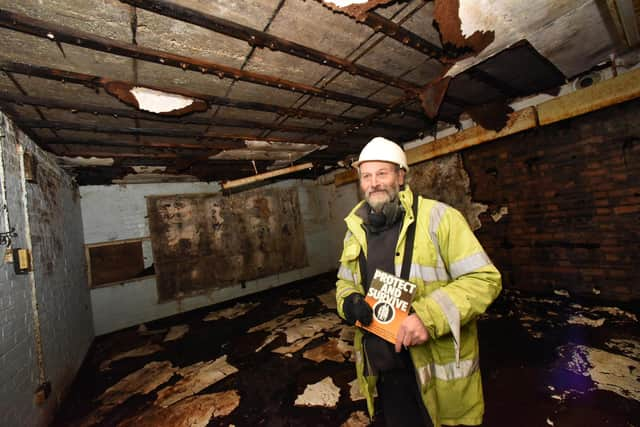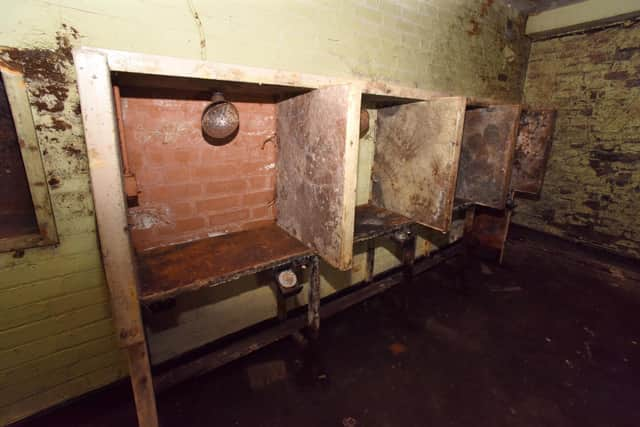Falkirk’s hidden nuclear bunk faces threat of demolition
and live on Freeview channel 276
The bunker – as it is now known to the few people who have heard of it – will soon be demolished along with the district court and council chambers close by.
It’s a fair bet that countless passers-by won’t have given it a second glance over the years – if they did, they probably assumed it was an electricity sub-station or something like that.
Advertisement
Hide AdAdvertisement
Hide AdBut this one-storey building was once Falkirk Council’s wartime headquarters – a base where the civil response to the growing threat from Russia would be coordinated.


Here, around 50 staff and Civil Defence volunteers would train regularly – ready to organise food, shelter, medicine and fuel supplies in the event of an attack on the UK, either nuclear or land-based.
“This was the command centre for the civilian population – it’s not where you command the army from,” Falkirk Community Trust’s archaelogist, Geoff Bailey explained, as he took one last look round.
In truth there’s not much left to see – with no windows, it’s pitch black inside – and without Geoff’s expertise it wouldn’t mean much.


Advertisement
Hide AdAdvertisement
Hide AdIt’s nickname is slightly misleading – although designed for the Cold War era, it is not a proper nuclear bunker, which would have been below ground.
Behind the door, now protected by a roller shutter, a long corridor leads to a series of rooms, long since abandoned in the almost derelict building.
Torchlight – and the camera flash – reveal brick walls running with damp which has caused the lining of the roof and walls to peel away into a soggy mess.
But there are still a few clues to its extraordinary past.
The most obvious are in the communication room, which contains rows of wooden, acoustic booths along two walls, telephones still attached.
Advertisement
Hide AdAdvertisement
Hide AdHere the telephonists – all staff from Falkirk Council – would write down any incoming messages on special pads, then pass them through hatches in the wall.
These led on one wall to the operations room, on the other to the scientific advisers.
In the operations room – the biggest room in the bunker – you can still see traces of huge maps of Falkirk.
Sadly, these days they’re just a soggy mess.
“You’d have your big maps on the walls, and the operators would move the symbols so you’d know where all your emergency services were based,” Geoff explained.
Advertisement
Hide AdAdvertisement
Hide AdAt the end of the corridor, would be the scientific advisers – two volunteers who were on hand to collate data, such as what direction the nuclear wind was blowing in and which part of the area was under threat.
Opposite would have been the liaison officers, who worked closely with the scientists, ready to provide instructions to the public.
Here there’s another clue to the building’s use that Geoff points out – a secret exit hidden in the bricks of the wall.
A hidden lintel meant it was possible to remove the bricks below without the rest of the wall collapsing, in case the front entrance should get blocked by bomb damage.
Advertisement
Hide AdAdvertisement
Hide AdThe other rooms included two toilets, two rest rooms that would be occupied in three shifts in the event of war, as well as a plant room and a kitchen.
The HQ was designed to operate for up to two weeks without any need to leave the building – but that might not have worked in practice, says Geoff.
Far from being able to respond to a four-minute warning, it would have taken around three weeks to ready it for action – stocking up on fresh water and food and even moving furniture in as tensions escalated.
“In theory, you should have two weeks supply here for 50 people when the alert goes out – but the chances are you wouldn’t because you don’t store stuff in here in advance,” said Geoff.
Advertisement
Hide AdAdvertisement
Hide Ad“Basically, you get the alert, put all the stuff in place and then come in here.”
The wartime HQ was built around 1950 as a replacement for one in Falkirk’s Dollar Park – just behind Arnotdale House – that had been used throughout the Second World War but had become too small.
It was actually built before the Municipal Buildings were – something that’s hard to imagine now.
“You would go down the hill to Westbank House, which was an Italianate villa that was bought from the Nimmo Family by Falkirk Council – so it wasn’t as enclosed as it is today.
Advertisement
Hide AdAdvertisement
Hide Ad“But even so, the vast majority of people have no idea this is here!
“The brick wall outside is in essence camouflage – it was put in when the municipal buildings were put in and it does a really good job!”
The staff and volunteers who took part in drills and trained in preparation for war were, of course, part of a much wider network.
Across Scotland were more volunteers looking after monitoring stations – tiny underground bunkers, including three in the Falkirk area, manned by volunteers.
Advertisement
Hide AdAdvertisement
Hide AdThe derelict bunker is one of a few reminders now of the Cold War era.
In truth, nothing could have prepared the country for the devastation that nuclear weapons would have brought to the entire country.
It’s a fascinating piece of Falkirk’s history, although probably not one that anyone will be sorry to leave behind.
